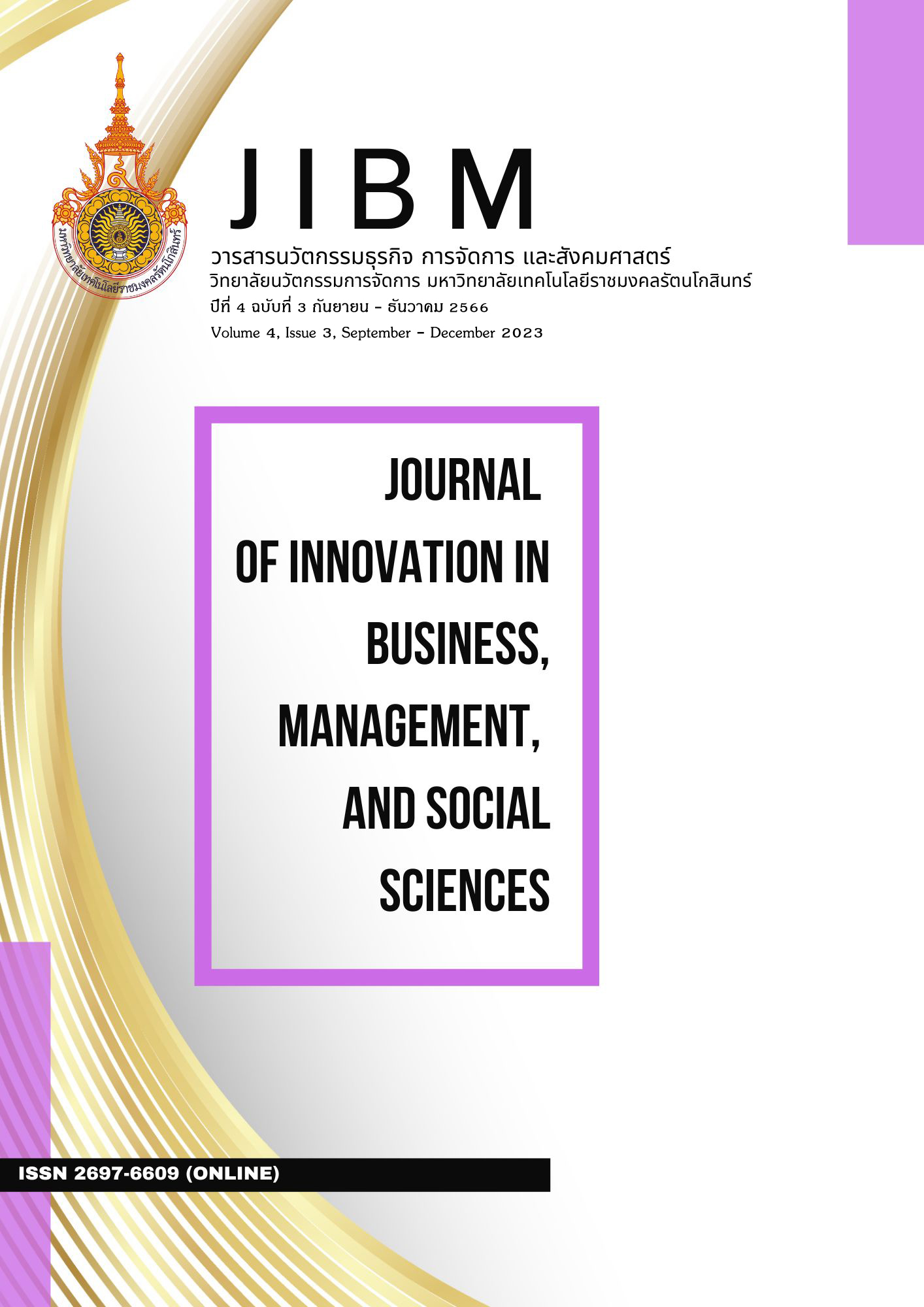Analyzing Water Demand and Allocation Considering Economic Dimensions: A Case Study of the Eastern River Basin
Keywords:
Water Allocation, Hybrid input-output table, Water footprint, Water intensityAbstract
This study has two main objectives: (1) to estimate the water demand in the Eastern River Basin and (2) to develop guidelines for allocating water resources to various sectors while considering the economic dimensions of the Eastern Sea River Basin. These findings will inform policy recommendations crucial for shaping the country's water management policies. Conducted as quantitative research, the study employs the following conceptual framework and data analysis tools: (1) A basin-level Input-Output (I-O) table incorporating water accounts. (2) Water demand indicators, including three key metrics: Water Footprint (WF), Water Input Content (WIC), and Water Intensity (WI). (3) Ghosh’s water use model for estimation.
The study's results highlight the following key points: (1) The industrial sector, while having the highest Water Footprint and water demand, both directly and indirectly, demonstrates remarkable efficiency in water utilization when compared to its production output. (2) The agricultural sector exhibits a relatively high demand for water, both directly and indirectly, yet it is less efficient in water usage compared to other production sectors. (3) The service sector displays lower demand for both direct and indirect water use compared to other production sectors and maintains a high level of water use efficiency. (4) Regarding water allocation guidelines in the Eastern Sea River Basin, prioritizing the industrial and service sectors for water allocation, with any remaining resources allocated to the agricultural sector, is deemed an appropriate approach, particularly when considering economic impacts.
References
Fleskens, L., Nainggolan, D., Temansen, M., Hubacek, K., & Reed, M. S. (2013). Regional consequences of the way land users respond to future water availability in Murcia, Spain. Regional Environmental Change, 13(3), 615-632. https://doi.org/10.1007/s10113-012-0283-8
Ghosh, A. (1958). Input-Output Approach to an Allocation System. Economica, 25, 58-64.
Guan, D. & Hubacek, K. (2007). Assessment of regional trade and virtual water flows in China. Ecological Economics, 61(1), 159-170. 10.1016/j.ecolecon.2006.02.022.
Han, M., Chen, G., Mustafa, M., Hayata, T., Shao, L., Li, J., . . . Ji, X. (2015). Embodied water for urban economy: A three-scale input–output analysis for Beijing 2010. Ecological Modelling, 318, 19-25.
Miller, R.E. (1998). Regional and Interregional Input-Output Analysis. In Isard, W., Azis, I.J., Drennan, M.P., Miller, R.E., Saltzman, S., & Thorbecke, E. (1998). Methods of Interregional and Regional Analysis. Routledge. https://doi.org/10.4324/9781315249056
Morrissey, K. (2014). Producing regional production multipliers for Irish marine sector policy: A location quotient approach. Ocean & coastal management, 91, 58-64.
Pahlow, M., Van Oel, M., Mekonnen, M.M., Hoekstra, A.Y. (2015). Increasing pressure on freshwater resources due to terrestrial feed ingredients for aquaculture production. Science of The Total Environment, 536, 847-857. https://doi.org/10.1016/j.scitotenv.2015.07.124
Shi, C., & Zhan, J. (2015). An input-output table based analysis on the virtual water by sectors with the five northwest provinces in China. Physics and Chemistry of the Earth, 79, 47-53.
Spörria, C., Borsuk, M., Peters, I., & Reichert, P. (2007). The economic impacts of river rehabilitation: A regional Input–Output analysis. Ecological Economics, 62(2), 341-351.
Sukhaparamate, S. (2014). National Water Footprint of Thailand and Tax Simulation. The International Journal of Economic Policy Studies, 8, 67-87.
Suttinon, P. (2008). Water Demand Management Model in Lower Chao Phraya River Basin, Thailand. Kochi: Kochi University of Technology.
เฟิลแคร์, มาร์ก, ธีรนงค์ สกุลศรี, และ ธีรนุช ก้อนแก้ว. (2562). โครงการแนวโน้มประชากรและความต้องการน้ำประปาในพื้นที่กรุงเทพมหานครและปริมณฑล. กรุงเทพฯ: สํานักงานคณะกรรมการส่งเสริมวิทยาศาสตร์ วิจัยและนวัตกรรม.
กระทรวงอุตสาหกรรม. (2559). ยุทธศาสตร์การพัฒนาอุตสาหกรรมไทย 4.0 ระยะ 20 ปี (พ.ศ. 2560-2579). สืบค้นจาก: https://waa.inter.nstda.or.th/stks/pub/2017/20171114-oie.pdf
ชัยยุทธ สุขศรี และคณะ. (2553). รูปแบบการจัดการทรัพยากรน้ำโดยการนำระบบสารสนเทศทรัพยากรน้ำเชิงพื้นที่ร่วมกับกระบวนการมีส่วนร่วมทางสังคมไปประยุกต์ใช้ในพื้นที่จังหวัดระยอง. กรุงเทพ: สำนักงานกองทุนสนับสนุนการวิจัย.
ณิชา สุภาพิมพ์ และ สุเมธ แก่นมณี. (2555). การพยากรณ์ความต้องการใช้นํ้าเพื่อการอุปโภคบริโภคในอนาคต โดยใช้แบบจำลองอารีมาและแบบจำลองการ์ช. วารสารวิจัย มข. (ฉบับบัณฑิตศึกษา), 11(1), 45-55.
นิพนธ์ พัวพงศกร และคณะ (2561) การพัฒนาโครงการชลประทานและการบริหารจัดการน้ำเพื่อให้เกิดประโยชน์เศรษฐกิจสูงสุด. กรุงเทพฯ: สถาบันวิจัยเพื่อการพัฒนาประเทศไทย.
บัญชา ขวัญยืน และคณะ. (2563) การบริหารและการประมวลผลการศึกษาโครงการวิจัย เพื่อจัดทำข้อเสนอแนะสมดุลน้ำและมาตรการลดการใช้น้ำ เพื่อการพัฒนาอย่างยั่งยืนในการพัฒนาระเบียงเศรษฐกิจพิเศษ ภาคตะวันออก (EEC). กรุงเทพฯ: สํานักงานคณะกรรมการส่งเสริมวิทยาศาสตร์ วิจัยและนวัตกรรม.
ปาณิศา วิชุพงษ์ และ ศุภวัฒน์ สุขะปรเมษฐ. (2560). การพัฒนาเครื่องมือในการประเมินความต้องการใช้น้ำของกลุ่มลุ่มน้ำภาคกลาง: รายงานฉบับสมบูรณ์. กรุงเทพฯ: สำนักงานคณะกรรมการส่งเสริมวิทยาศาสตร์ วิจัยและนวัตกรรม.
ภาวิณี ศักดิ์สุนทรศิริ และคณะ. (2555). การจัดทำตารางปัจจัยการผลิตและผลผลิตเพื่อการศึกษาผลกระทบเชิงเศรษฐกิจ ความต้องการน้ำ และพลังงานของจังหวัดระยอง. กรุงเทพฯ: สำนักงานกองทุนสนับสนุนการวิจัย.
วันชัย สุขขี. (2542). ความต้องการใช้น้ำเพื่อการอุตสาหกรรมในนิคมอุตสาหกรรมแหลมฉบัง (วิทยานิพนธ์มหาบัณฑิต). ชลบุรี: มหาวิทยาลัยบูรพา.
ศุภวัจน์ รุ่งสุริยะวิบูลย์ , รุ่งนภา โอภาสปัญญาสาร และ เพ็ชรธรินทร์ วงศ์เจริญ. (2563). การพยากรณ์ความต้องการใช้น้ำของไทยด้วยวิธีมูลค่าส่วนเพิ่มจากการใช้น้ำ. Discussion Paper No.54 สืบค้นจาก: https://www.econ.tu.ac.th/uploads/discussion_paper/file/20200805/acfghjprtv69.pdf
สภาอุตสาหกรรมแห่งประเทศไทย สถาบันน้ำและสิ่งแวดล้อมเพื่อความยั่งยืน. (2561). แนวทางการประเมินการใช้น้ำภาคอุตสาหกรรมสำหรับประเทศไทย. กรุงเทพฯ: บริษัท นีโอ ดิจิตอล จำกัด.
สํานักบริหารจัดการน้ำ. (ม.ป.ป.). การประเมินความต้องการน้ำอุปโภค บริโภค และอุตสาหกรรม. สืบค้นจาก: http://water.rid.go.th/wrd/const14/images/KL/KL4.pdf
สำนักงานคณะกรรมการนโยบายเขตพัฒนาพิเศษภาคตะวันออก. (2561). แผนภาพรวมเพื่อการพัฒนาเขตพัฒนาพิเศษภาคตะวันออก พ.ศ. 2560-2565. สืบค้นจาก: https://eeco.or.th/th/filedownload/1478/cf4092afd2456bb1f03995574db27a75.pdf
สำนักงานคณะกรรมการพัฒนาการเศรษฐกิจและสังคมแห่งชาติ. (2559). แผนงานพัฒนาระเบียงเศรษฐกิจภาคตะวันออก (พ.ศ. 2560-2564). สืบค้นจาก: https://www.nesdc.go.th/ewt_dl_link.php?nid=6381
สุจริต คูณธนกุลวงศ์ และคณะ. (2550). โครงการผลการเปลี่ยนแปลงสภาพภูมิอากาศโลกต่อปริมาณน้ำฝน/น้ำท่วมรายเดือนของประเทศไทย และผลกระทบต่อการบริหารจัดการน้ำในพื้นที่ภาคตะวันออก. กรุงเทพฯ: สำนักงานกองทุนสนับสนุนการวิจัย.
สุจริต คูณธนกุลวงศ์ และคณะ. (2557). โครงการศูนย์วิจัยระบบการวางแผนจัดการทรัพยากรน้ำ เพื่อความมั่นคงระดับจังหวัด ระยะที่ 3. กรุงเทพฯ: สำนักงานกองทุนสนับสนุนการวิจัย.
สุจริต คูณธนกุลวงศ์, โชคชัย สุทธิธรรมจิต, และ วรรณวลี วงศ์เกษมสันต์. (2550). แนวทางการสํารวจการใช้น้ำและการประมาณความต้องการใช้น้ำภาคอุตสาหกรรม. กรุงเทพฯ: จุฬาลงกรณ์มหาวิทยาลัย.
สุภารัตน์ พิลางาม และ อรรจน์ เศรษฐบุตร. (2561). การใช้น้ำประปาและการคาดการณ์การใช้น้ำของโรงแรมในกรุงเทพมหานคร. การประชุมวิชาการ BETAC ครั้งที่ 5. 29 มิถุนายน 2561, หน้า 1-12. ขอนแก่น: คณะสถาปัตยกรรมศาสตร์ มหาวิทยาลัยขอนแก่น.


